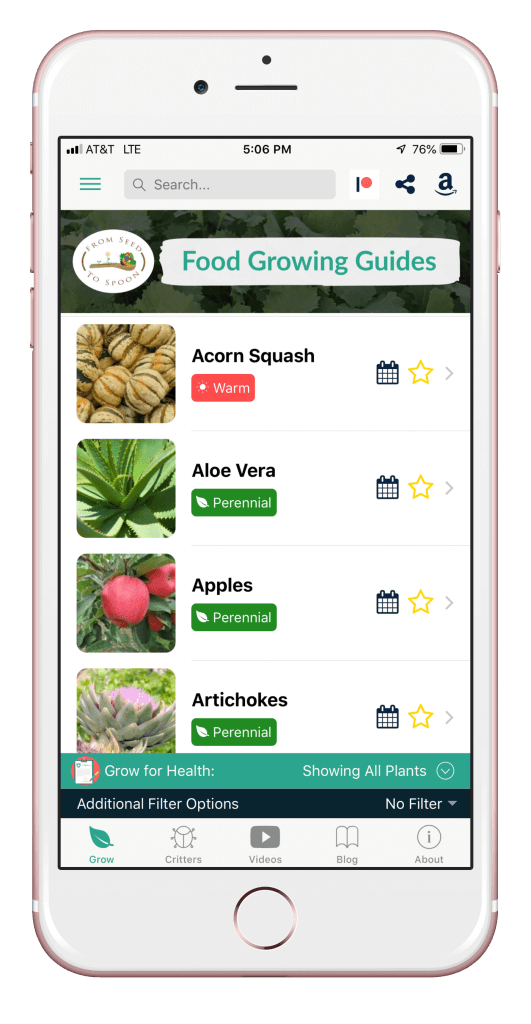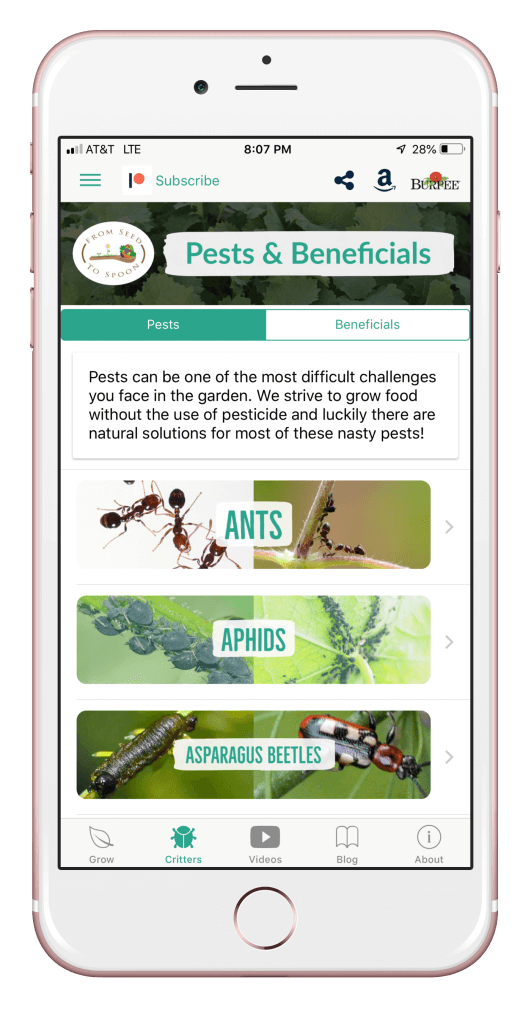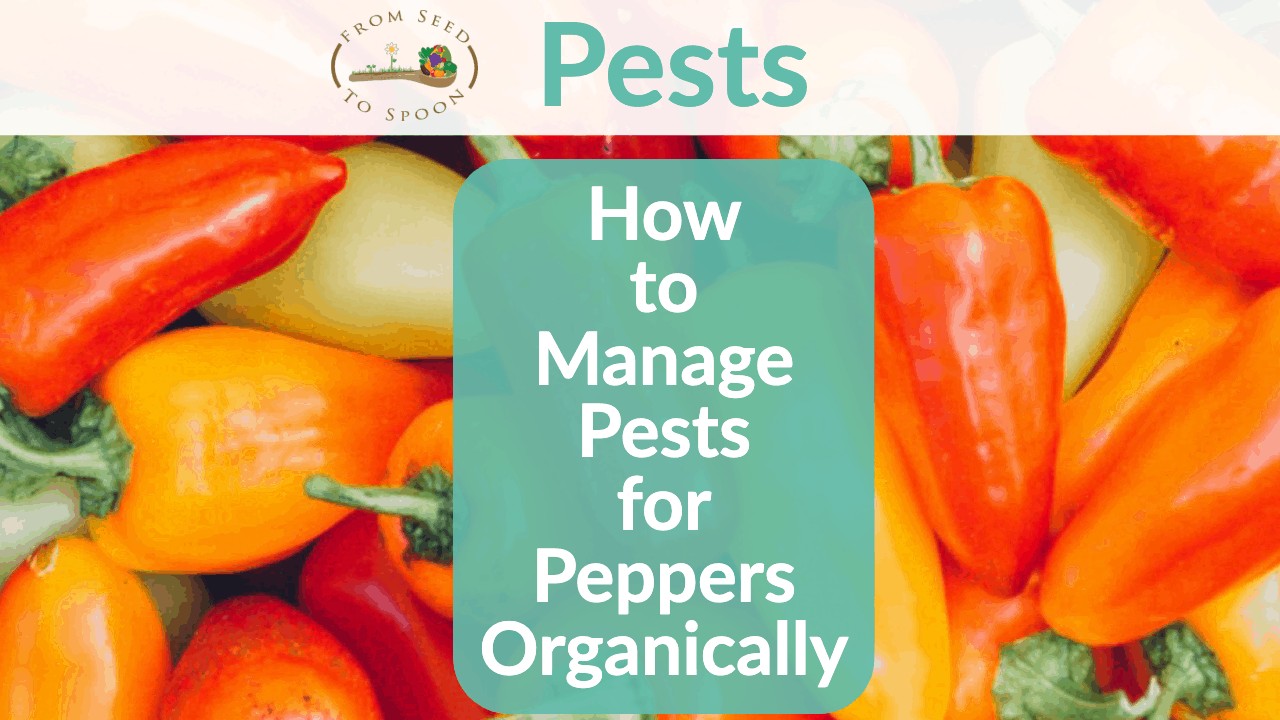
Aphids are tiny insects that can usually be found in groups on the undersides of leaves and stems. A few aphids can’t do much, but they reproduce quickly, are born pregnant, and can take over a plant in no time at all!
Treatment Options:
- Spray aphids off leaves with a blast of water from the sprayer and repeat as necessary for a few days
- Ladybugs are valuable ally and can be purchased to help with aphid control. Make sure you release them at night on plants that are infested with aphids, and it wouldn’t hurt to provide a source of water as well. They will quickly mate and lay their eggs, resulting in alligator-shaped larvae hatching and devouring aphids. A single ladybug can eat up to 5,000 aphids in their lifetime!
- Buy Ladybugs on Amazon!
- Green lacewing larvae are voracious predators of many soft bodied insect pests, including several species of aphids, spider mites, thrips, whiteflies, leafhoppers, and others.
- Buy Green Lacewings on Amazon!

Treatment Options:
- Green lacewings and trichogramma wasps can help to fight against the corn borer eggs.
- Beneficial nematodes have been shown to be effective if you have a bad infestation.
- Use the organic pesticide, BTK (bacillus thuringiensis Kurstaki). BTK is a naturally occuring microorganism that sickens and kills caterpillars without harming butterflies, bees, and other beneficial insects. There are varied opinions regarding the safety of BTK, but it’s classified as an organic treatment and is certainly safer than using a more toxic pesticide.

Treatment Options:
- Cover the plants with insect netting (floating row covers) from when they are babies. This will help to prevent them from becoming an issue!
- Cardboard “collars” can be made from toilet rolls or paper towel rolls and placed around each seedling to keep these cutworms out. You can also place toothpicks around seedlings so the worm cannot wrap around the stem.
- Diatomaceous earth can also be laid down around your seedlings to help get rid of them.
- Sprinkling coffee grounds or crumbled egg shells can help repel them from your seedlings as well.

Flea beetles are the extremely tiny insects that jump when disturbed. Even though these beetles are super small, they can quickly move through the leaves of plants, destroying the foliage in its path and spreading diseases.
Treatment Options:
- Insect netting (floating row covers) provide the best form of protection against flea beetles.
- Applying beneficial nematodes and neem oil can also be effective. Make sure not to apply the neem oil when the temperature is above 90, or else you could suffocate your plant!
- Sprinkle diatomaceous earth over areas you want to protect. Be careful though: DE can harm beneficial insects as well if they come in contact with it.
- Using a yellow sticky trap can trap these adults before they have a chance to lay their eggs.

Treatment Options:
- Hand-picking and squishing or placing them in a soapy water bucket is a great way to get rid of these pests.
- Companion planting can help deter leaf-footed bugs. Sunflowers are especially good at attracting these pests away from other plants.
- Another good prevention is to remove excess weeds and grass around the garden areas as this can help to attract them.
- Placing insect netting (floating row covers) over your garden is the best way to prevent leaf-footed bugs from attacking your plants.
- Diatomaceous earth can also be laid down around your garden to help get rid of them.
- Applying neem oil can also be effective for the nymph stage of leaf-footed bugs. Make sure not to apply the neem oil when the temperature is above 90, or else you could suffocate your plant!

Treatment Options:
- The best treatment for nematodes is prevention! Practicing crop rotation from year to year is essential.
- Simply tilling the soil over multiple times throughout the fall and winter months can help to prevent these infestations.
- Adding in new organic matter (compost) when you replant helps to keep nematodes at bay.
- Burn & turn is a term used commonly to get rid of these types of pests in the soil. When your soil is empty of vegetative growth, turn your soil and use a flame thrower to burn the top layer of the soil. If you do not have a flame thrower you can use a dark color plastic sheet to cover over the summer months to heat the temperature of the soil up to a high enough temperature to kill the nematodes.

Treatment Options:
- Hand-picking and placing the beetle in a soapy water bucket is a great way to get rid of them.
- Companion planting can help deter potato beetles.
- Diatomaceous earth can also be laid down around your garden to help get rid of them.
- Beneficial insects such as green lacewings and ladybugs can be helpful to fight these beetle’s larvae. You can either try to attract them or buy them to release!
- Applying beneficial nematodes and neem oil can also be effective. Make sure not to apply the neem oil when the temperature is above 90, or else you could suffocate your plant!

Treatment Options:
- Hand-picking them and placing in a bucket of soapy water is the best option to control these pests. They can sometimes be challenging because they like to hold on tight to the plant.
- A great way to help control hornworms is with trichogramma wasps. They can be purchased and released in your garden to help! Ladybugs can also be a help to eat the eggs.
- Tomato hornworms can also be treated using the organic pesticide, BTK (bacillus thuringiensis Kurstaki). BTK is a naturally occuring microorganism that sickens and kills caterpillars. There are varied opinions regarding the safety of BTK, but it’s classified as an organic treatment and is certainly safer than using a more toxic pesticide.
- Sprinkle diatomaceous earth over areas you want to protect. Be careful though: DE can harm beneficial insects as well if they come in contact with it.

Treatment Options:
- We’ve found a great treatment for mice and voles is to have a house full of dogs and cats. They do a great job in helping to keep them under control. In case you do not have a cat or dog that enjoys to hunt down mice, there are a few options for taking care of this problem yourself.
- Out of everything, we’ve found the tried and true mouse trap to be the most effective solution. We really like the plastic and metal traps found on Amazon. Simply put a little peanut butter or dog food on the trap and set it out near active spots. There are also electric ones that make it things much easier!
- There are ultrasonic pest repellers that you can place in the ground that send vibrations out to scare the mice away and out of your garden.
- Stationing a fake owl around the garden can also be helpful to scare away field mice. Be sure to move the owl around, or they might figure out your trick!
Learn more about growing over 100 different foods, including how to manage various pests in our FREE iOS, Android, or Universal Web App!



Carrie Spoonemore, co-founder of “From Seed to Spoon,” stands as a beacon of inspiration for gardeners and health enthusiasts alike. Her journey alongside her husband, Dale Spoonemore, in creating a platform that demystifies gardening and promotes a healthier lifestyle, has made a significant impact on individuals around the globe. Through the “From Seed to Spoon” app, Carrie has dedicated herself to empowering people to take control of their health and environment by growing their own food.
With a profound belief in the power of gardening to improve mental and physical health, Carrie’s contributions to the Seed to Spoon blog reflect her holistic approach to wellness. Her articles often focus on the nutritional benefits of homegrown fruits and vegetables, organic gardening practices, and the mental health benefits of spending time in nature. Carrie’s expertise in health science shines through in her detailed discussions on how specific plants can contribute to a balanced diet and overall well-being.
Carrie’s passion for gardening is deeply intertwined with her commitment to family and community wellness. She frequently shares personal stories of how gardening has brought her family closer together, offering practical tips for involving children in gardening activities and making it a fun, educational experience. Her writing encourages families to explore gardening as a means of spending quality time together while learning about nature and sustainability.
In addition to gardening advice, Carrie’s contributions to the blog include insights into the use of technology to enhance the gardening experience. She has played a crucial role in designing the “From Seed to Spoon” app to be user-friendly, ensuring that users of all ages and backgrounds can navigate the complexities of gardening with ease. Her vision for the app is not just as a gardening tool but as a vehicle for change, inspiring individuals to adopt a more sustainable lifestyle by growing their own food.
Carrie Spoonemore’s presence on the blog is marked by her compassionate approach to teaching and her unwavering belief in the transformative power of gardening. Her work continues to inspire a community of gardeners to pursue a healthier, more sustainable way of living, proving that with the right tools and knowledge, anyone can become a gardener and advocate for their health and the planet.






